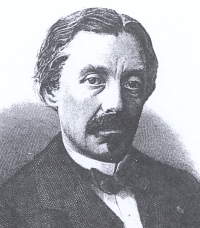Léon Foucault
| Léon Foucault | |
 Léon Foucault (1819-1868)
|
|
| Born | September 18 1819 Paris, France |
|---|---|
| Died | February 11, 1868 (aged 48) Paris, France |
| Residence | France |
| Nationality | French |
| Fields | Physics |
| Institutions | Paris Observatory |
| Known for | Foucault Pendulum |
Jean Bernard Léon Foucault (IPA: [ʒɑ̃ bɛʁnaʁ leɔ̃ fu'ko]) (18 September 1819 – 11 February 1868) was a French physicist best known for the invention of the Foucault pendulum, a device demonstrating the effect of the Earth's rotation. He also made an early measurement of the speed of light, discovered eddy currents, and although he didn't invent it, is credited with naming the gyroscope. The Foucault crater on the Moon is named after him.
Contents |
Early years
Foucault was the son of a publisher at Paris, where he was born on September 18, 1819. After an education received chiefly at home, he studied medicine, which, however, he speedily abandoned for physical science due to a fear of blood.[1] He first directed his attention to the improvement of L. J. M. Daguerre's photographic processes. For three years he was experimental assistant to Alfred Donné (1801–1878) in his course of lectures on microscopic anatomy.
With A. H. L. Fizeau he carried on a series of investigations on the intensity of the light of the sun, as compared with that of carbon in the arc lamp, and of lime in the flame of the oxyhydrogen blowpipe; on the interference of infrared radiation, and of light rays differing greatly in lengths of path; and on the chromatic polarization of light.
Middle years
In 1850, he did an experiment using the Fizeau–Foucault apparatus to measure the speed of light; it come to be known as the Foucault–Fizeau experiment, and was viewed as "driving the last nail in the coffin" of Newton's corpuscle theory of light when it showed that light travels more slowly through water than through air.[2]
In 1851 he provided the first experimental demonstration of the rotation of the Earth on its axis (see diurnal motion). This was achieved by considering the rotation of the plane of oscillation of a freely suspended, long and heavy pendulum in the Panthéon in Paris. The experiment caused a sensation in both the learned and popular worlds. In the following year he used (and named) the gyroscope as a conceptually simpler experimental proof. In 1855 he received the Copley Medal of the Royal Society for his 'very remarkable experimental researches'. Earlier in the same year he was made physicien (physicist) at the imperial observatory at Paris.
In September 1855 he discovered that the force required for the rotation of a copper disc becomes greater when it is made to rotate with its rim between the poles of a magnet, the disc at the same time becoming heated by the eddy current or "Foucault currents" induced in the metal.
In 1857, Foucault invented the polarizer which bears his name, and in the succeeding year devised a method of testing the mirror of a reflecting telescope to determine its shape. The so-called "Foucault Test" allows the worker to tell if the mirror is perfectly spherical, or if it deviates from a sphere. Prior to Foucault's invention, testing reflecting telescope mirrors was a "hit or miss" proposition. With Charles Wheatstone’s revolving mirror he in 1862 determined the speed of light to be 298,000 km/s (about 185,000 mi./s) —10,000 km/s less than that obtained by previous experimenters and only 0.6% off the currently accepted value.
Later years
In that year, he was made a member of the Bureau des Longitudes and an officer of the Légion d'Honneur. In 1864 he was made a member of the Royal Society of London, and the next year a member of the mechanical section of the Institute. In 1865 his papers on a modification of Watt's governor appeared, upon which he had for some time been experimenting with a view to making its period of revolution constant, and on a new apparatus for regulating the electric light; and in the year (Compt. Rend. lxiii.) he showed how, by the deposition of a transparently thin film of silver on the outer side of the object glass of a telescope, the sun could be viewed without injuring the eye. His chief scientific papers are to be found in the Comptes Rendus, 1847—1869.
Death and afterwards

Foucault died of what was probably a rapidly-developing case of multiple sclerosis[3] on February 11, 1868 in Paris and was buried in the Cimetière de Montmartre.
Further reading
- Amir D. Aczel, Pendulum: Léon Foucault and the Triumph of Science, Washington Square Press, 2003, ISBN 0-7434-6478-8
- William Tobin, Perfecting the Modern Reflector. Sky & Telescope, October 1987.
- William Tobin, Léon Foucault. Scientific American, July 1998.
- William Tobin, The Life and Science of Léon Foucault: The Man who Proved the Earth Rotates. Cambridge University Press, 2003. ISBN 0-521-80855-3
External links
Collected Works:
- Volume One - Recueil des travaux scientifiques de Léon Foucault 1878.
- Volume Two - Recueil des travaux scientifiques de Léon Foucault 1878.
Other:
- Foucault Disk - Interactive Java Tutorial Foucault created this device showing how eddy currents work (National High Magnetic Field Laboratory)
- Donné & Foucault Atlas of medical micrographs 1845
References
- ↑ "Jean-Bertrand-Léon Foucault". Catholic Encyclopedia. (1913). New York: Robert Appleton Company.
- ↑ David Cassidy, Gerald Holton, James Rutherford (2002). Understanding Physics. Birkhäuser. ISBN 0387987568. http://books.google.com/books?id=rpQo7f9F1xUC&pg=PA382&dq=Foucault+speed-of-light+wave+theory&as_brr=3&ei=qhMTSbjcN5zOswOIhPG6DQ.
- ↑ W. Tobin, The Life and Science of Léon Foucault, Cambridge University Press (2003).